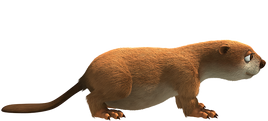
Castorocauda is a genus of small, semi-aquatic mammal relatives living in the Jurassic period, around 164 million years ago, found in lakebed sediments of the Daohugou Beds of Inner Mongolia. It contains the single species Castorocauda lutrasimilis. They were highly specialized, with adaptations evolved convergently with those of modern semi-aquatic mammals such as beavers, otters, and the platypus.
Classification
Castorocauda lutrasimilis is a member of the order Docodonta, which is a wholly extinct group of Mammaliaformes. It is not considered to be a mammal by the crown group definition, which takes the mammals to be the group containing the most recent common ancestor of all living mammals (the monotremes, placentals, and marsupials) and its descendants. Many writers, however, do not define Mammalia as a crown group; Kielan-Jaworowska et al. (2004), for example, defines Mammalia as the group originating with the last common ancestor of Sinoconodon and living mammals, a definition that includes Docodonta.[1]
A Castorocauda fossil was discovered in 2004 in the fossil-rich beds of Liaoning province, China; it was reported in the journal Science by an international team led by Qiang Ji of Nanjing University.[2] The fossil was so well preserved that an important feature of its soft anatomy — hair — was preserved. Hair is present in all modern mammals and is therefore assumed, under principles of maximum parsimony, to have been present in all descendants of the last common ancestor of Castorocauda and today's mammals, including crown mammals and other docodonts. The hair appears to have been a very advanced dense pelage including guard hairs and underfur.
The tiny auditory ossicles of the middle ear and associated areas were also well preserved in this Castorocauda fossil. Features of these bones confirms the evolutionary position of docodonts as more closely related to crown-group mammals than is Morganucodon. They are, however, less closely related to living mammals than is Hadrocodium.
Among docodonts, Castorocauda appears to have been related to Krusatodon and Simpsonodon, both European animals. This may be evidence that Europe and Asia underwent a faunal interchange in the Middle Jurassic. The two continents would later be separated by the Turgai Strait.
Adaptation to water
The name Castorocauda lutrasimilis is derived from the Latin castor- meaning "beaver", -"cauda" meaning "tail", lutra meaning "otter", and -similis meaning "similar to". The tail was broad with scales interspersed with hairs that grew less frequent toward the tip. Overall it was very similar to the tails of modern beavers and was presumably used for locomotion in water in a similar fashion. The caudal vertebrae were flattened dorso-ventrally and similar overall to those in a beaver or otter. Fossilized impressions of some webbing is also present between the toes.
Features of the limbs suggested that it may have been adapted for digging. The forelimbs are robust, with enlarged olecranon and other processes associated with strong muscle attachment. The limbs are similar to the modern platypus, an animal that both digs and swims. Castorocauda, Haldanodon and perhaps other docodonts were fossorial. These early specializations were also present in the crown-group mammal Fruitafossor, also from the late Jurassic.
Docodonts in general have distinctive teeth, and the teeth of Castorocauda have the distinguishing features of the group. The teeth of Castorocauda are different in many ways from all other docodonts, presumably due to a difference in diet (though see below). Most docodonts had teeth specialized for an omnivorous diet. The teeth of Castorocauda suggest that the animal was a piscivore, feeding on fish and small invertebrates. The first two molars had cusps in a straight row, eliminating the grinding function suggesting that they were strictly for gripping and not for chewing. This feature of three cusps in a row is similar to the ancestral condition in mammal relatives (as seen in triconodonts), but is almost certainly a derived character in Castorocauda. These first molars were also recurved in a manner designed to hold slippery prey once grasped. These teeth are very similar to the teeth seen in mesonychids, an extinct group of semi-aquatic carnivorous ungulates, and resemble, to a lesser degree, the teeth of seals.
The complete dental formula was not recoverable, but the lower jaw contained 4 incisors, 1 canine, 5 premolars, and 6 molars.
The animal probably weighed about 500-800 grams (1 pound to nearly 2 pounds) and grew to at least 42.5 cm (17 inches) in length. This makes it the largest mammaliaform (including true mammals) of the Jurassic. The previous record holder was Sinoconodon which was thought to weigh up to 500 g.
At least another docodont, Haldanodon, was adapted to a semi-aquatic lifestyle. Docodonts as a whole might have had tendencies towards aquatic habits given their prevalence in aquatic deposits.[3]
Fossil evidence
The fossil was from the Daohugou Beds of the Inner Mongolia region of China. Fossils of pterosaurs, lissamphibians, coelurosaurian dinosaurs, and numerous invertebrates have also been unearthed in the same formation.
It was discovered and described by Qiang Ji and Chong-Xi Yuan of the Chinese Academy of Geological Sciences in Beijing and Zhe-Xi Luo and Alan Tabrum of the Carnegie Museum of Natural History.
Importance of discovery
The discovery of Castorocauda lutrasimilis is the first sign that a close relative of mammals adapted to water before dinosaurs lost dominance 66 million years ago, pushing back the estimated date for mammal relatives adapted to a semi-aquatic lifestyle by 110 million years. Based on fossils known at present, the mammal line would not see another semi-aquatic form evolve until the Eocene. Because few fossilized remains had been found, it was previously thought that, until the Cretaceous–Paleogene boundary (K–T boundary), all mammals were tiny, ground-dwelling or tree-dwelling, nocturnal animals akin to shrews, hedgehogs, treeshrews, or tenrecs. This notion has now been falsified by the armadillo-like Fruitafossor, the dinosaur-eating Repenomamus, the flying squirrel-like Volaticotherium and now the otter-like Castorocauda.